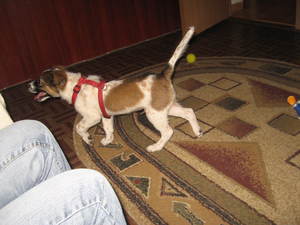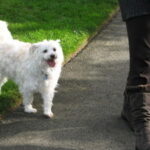Here are some basic rules for training your pet:
1. The training should be a pleasant experience both for the dog and for you. If you don’t have the necessary mood, than don’t start. The training session should be short, from 5 to 10 minutes, in order to maintain the motivation of your little dog.
If the dog doesn’t answer to your orders, after several attempts, do not reward him. Go back to simple commands and then start again with the more complex ones. End the training session positively.
Learn your dog to respond to an order that you know for sure that it will comply. Reward him and finish the training by letting your dog free. Avoid usual words like ‘ok’.
2. Any dog should be familiar with basic commands like: come, sit, and sit down. Other useful commands are: leave it, give it, stop or enough.
Remember that the motivation of a puppy decreases as the command is more complex. From the perspective of the dog, the question is: ‘What is best: running after a squirrel or return to his master?’ Understanding this issue will increase his patience and success.
3. The dog training should not include penalties. So, don’t yell to him, don’t hit your dog, don’t tighten his leash and never use electric shocks.
Remember that the opposite of the reward is not the punishment, but the lack of reward. Most dogs want to enjoy their owners; even it’s only for food, attention or toys.
4. If food is the reward, do the dog training before feeding him, not after. If the reward consists in caresses, then train the puppy when he needs most your attention, when you return from work, for example.
5. The reward must suit to the type of motivation that works best for him. Dogs who are motivated by food must receive their favorite food. The pieces of food must be small, and the texture must be one which doesn’t require mastication, because the attention of the dog will disappear.
If the reward consists in caresses, you must know that most dogs don’t like caresses on their head, but rather on the chest.
6. After a correct answer, reward your dog in the first half of second in command from the command, in order to be sure that your pet associates his behavior with the reward received.
7. Use short orders like: sit, down, leave it. Say the word once. Don’t repeat the command. Dogs will remember the command for two minutes. Excepting short words, it’s good to use words with strong consonants: c, k, t, x. Mention the name of your pet before releasing the order, and if the result was successful, tell him that it was good.
8. Increases gradually the time in which your dog must remain in the required position, until he takes a relaxed position for one minute and you are at 1, 5 meters from him.
9. Change the commands during a dog training session. Keep the session short, but do them frequently. Dogs will learn more from short and repeated training sessions than from those which are long and irregular.
Initially, the dog should be rewarded on 2 of 3 successful sessions, then on one session, until he will receive only occasionally a reward.
10. After the training took place into a quiet place, you can start working in areas with multiple elements that can attract your dog’s attention. First, keep him into a leash, and then release him gradually.
Sources: www.dogproblems.com, www.dogtrainingclassroom.com, dogtrainingways.com






